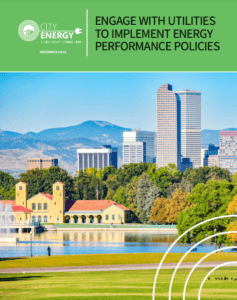As part of the City Energy Project, IMT released two guides for cities and utilities that offer information about how to partner effectively to drive deeper energy efficiency.
Engage with Utilities to Implement Energy Performance Policies offers practical advice and a checklist to local governments that are exploring building performance policies like benchmarking and transparency. Engage with Utilities will help cities proactively work with their utilities to ensure high compliance and promote participation in other energy efficiency programs.
How Utilities Can Support Cities as Their Customers uses lessons learned from City Energy Project and other efforts to provide practical advice to utilities, with a focus on key accounts representatives, on how to understand city energy goals and provide corresponding excellent customer service that helps the city and utility mutually achieve deeper energy efficiency. This post highlights one of City Energy Project’s excellent examples of partnership between cities and utilities, which is referenced in these guides.

St. Louis, Missouri is not only the “Gateway to the West,” it’s also the site of a growing city-utility partnership to make buildings more efficient. The City of St. Louis and the Missouri Gateway Chapter of the U.S. Green Building Council (USGBC-MGC) are working in concert with Ameren Missouri, an electric utility, and Spire Inc., a natural gas utility, to promote the city’s Building Energy Awareness Ordinance. Together, these entities are showing how communicating about shared goals and coordinating complementary strengths can lead to deeper efficiency.
The ordinance, which was passed in 2017, requires privately and municipally owned buildings over 50,000 square feet to benchmark using ENERGY STAR Portfolio Manager and disclose their annual energy and water consumption. In order to comply with the ordinance, St. Louis building owners need to request the energy usage of their buildings. A growing number of leading utilities—such as Commonwealth Edison in Illinois and Xcel Energy in Denver and Minneapolis—allow building owners to obtain total energy usage where there is a threshold number of tenants, saving owners time while increasing the accuracy of the data they receive. Ameren Missouri is one of the most recent utilities to adopt this practice to aid building owners to become more efficient. (See EPA’s fact sheet and interactive map on utilities that provide energy data for benchmarking.)
Creating this process for St. Louis was a collaborative effort that built on longstanding relationships between Ameren Missouri and USGBC-MGC. In advance of the ordinance, the Natural Resources Defense Council (NRDC) worked with Ameren Missouri to include a commitment to provide whole-building data as part of a settlement around energy efficiency that the Missouri Public Service Commission (PSC) approved. Ameren Missouri, the city, and USGBC-MGC then got to work figuring out the data request process. They agreed on data request forms and Ameren Missouri prepped its customer care team to manage data requests. The City Energy Project, a joint initiative of IMT and NRDC, provided examples of practices from other utilities and made utility-to-utility connections to help the group visualize key steps.
To date, Ameren Missouri has provided whole-building electricity data for approximately 400 customers, over 70 percent of the buildings that complied with the city’s ordinance. Ameren Missouri’s team envisions real operational benefits as it expands this effort—in fact, it filed an application with the PSC to make the data request process electronic and use the results to identify where customers could benefit from energy efficiency programs. The PSC approved this approach as part of a settlement around Ameren Missouri’s future energy efficiency offerings.
One of the strengths of this partnership is that the entities have been each other’s champions to building owners and other customers. The city’s building inspectors, who help monitor compliance with the Building Energy Awareness Ordinance, are taking an active role in informing building owners about Ameren Missouri’s BizSavers® efficiency programs. And the city and USGBC-MGC have praised Ameren Missouri’s team for collaborating by participating in city advisory groups and educational trainings on Portfolio Manager, as well as for working to continue to build out their efficiency services.
According to Rajiv Ravulapati, Government Services Analyst for the City of St. Louis,
Ameren Missouri has been a supporter of our benchmarking ordinance and City Energy Project from the get-go. Their energy efficiency team has shown the city their commitment on improving the benchmarking experience for building owners. One of their latest initiatives to come in 2019 is starting to allow customers to verify multiple electric accounts associated with a single facility and automatically upload the aggregated data directly into ENERGY STAR Portfolio Manager. Another great result from continuing to communicate the needs of customers to Ameren Missouri.
Emily Andrews, the Executive Director of USGBC-MGC, adds:
Without support and engagement from Ameren Missouri, benchmarking and energy efficiency success would take a lot longer.
Marco Tipton, Program Specialist—Energy Efficiency for Ameren Missouri, agreed:
Ameren Missouri is excited to work with the City of St. Louis and the USGBC-MGC to create a path for our customers to achieve even deeper energy efficiency. The technical expertise we’ve developed will help us continue to deliver excellent service to our customers. Key to the process has been our ability to work collaboratively with these partners to achieve shared goals in St. Louis.
Benchmarking and transparency programs offer a pathway to identify under-performing buildings that may benefit from energy efficiency. This means that the groundwork being laid by the Building Energy Awareness Ordinance—and the efforts of other cities—can provide further opportunities to engage building owners around efficiency, and maybe even to develop new and creative efficiency programs that combine the outreach abilities of cities and community partners with the technical and financial resources of utilities.
 We look forward to the many great things that are still to come from this powerful partnership. In the interim, readers interested in learning more about how to maximize city-utility partnerships should check out Engage with Utilities to Implement Energy Performance Policies, which provides recommendations on how cities and utilities can work together to identify shared energy efficiency goals and implement new policies and programs.
We look forward to the many great things that are still to come from this powerful partnership. In the interim, readers interested in learning more about how to maximize city-utility partnerships should check out Engage with Utilities to Implement Energy Performance Policies, which provides recommendations on how cities and utilities can work together to identify shared energy efficiency goals and implement new policies and programs.
